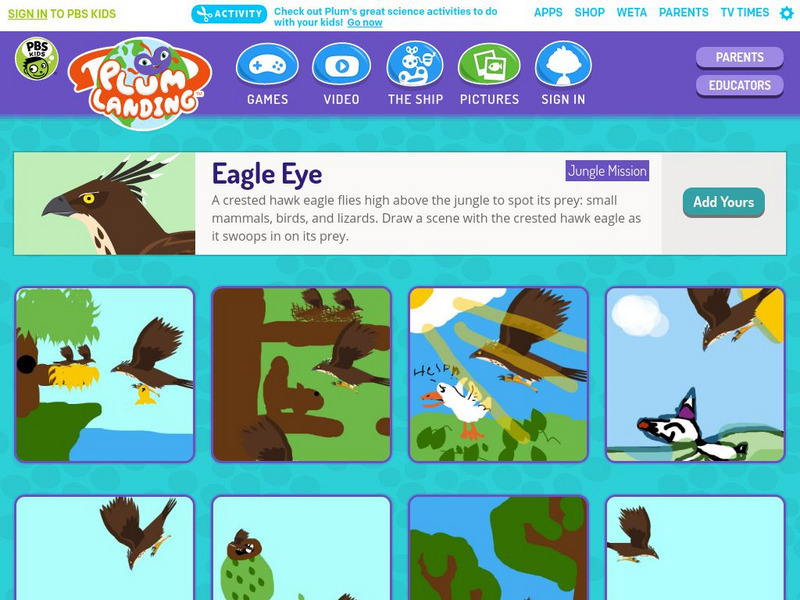TED Talks
Ted: Ted Ed: Can Animals Be Deceptive?
Eldridge Adams details the surprising complexity of how animals manipulate predators, prey and their rivals.
Ed Koday
Web Archive: Ambush Bug
Ambush bugs are predators which normally lie in wait for prey. They have front legs fitted for grasping, much like that of a praying mantis. They commonly sit on a flower waiting for insects attracted to flowers. Goldenrod is a favorite...
PBS
Pbs Kids: Plum Landing: Mangroovin'
In this game, players take on the role of baby groupers, fish who grow up in the shelter of mangrove roots. They need to swim into open water to find food without falling prey to hungry predators.
Ed Koday
Web Archive: Antlion
Have you ever heard of a "doodlebug"? Well, you're looking at one right up above! It is actually an insect called an antlion. The antlion gets its name because it is a voracious predator of ants and other insects. Actually, it's only the...
Concord Consortium
Concord Consortium: Stem Resources: Predators and Prey
Did you ever want to be a hawk? In this virtual ecosystem, students will take on the role of a hawk and try to catch rabbits on a snowy field. Students will see which rabbits have adaptations that allow them to blend into the environment...
Sea World Parks & Entertainment
Sea World: Raptors
Outlines the characteristics of birds of prey, including classification, habitat, behaviors, and conservation. Helps students identify with these birds by integrating a list of "Books for Young Readers." Information at a level of upper...
Other
Pde Sas: Relationships Among Organisms
In this lesson, students compare various types of relationships among organisms (i.e., biotic interactions). Students will: explain the roles of producers and consumers, and predators and prey in an ecosystem. Explain the levels of order...
Science Education Resource Center at Carleton College
Serc: Food Chains: Nature's Restaurant
Students begin this lesson by making observations and recording evidence of the variety of living things in local nature site. Students use reference materials to research predators and food of the animals they observed, then illustrate...
Science Buddies
Science Buddies: M&m Survival Challenge
In the wild, there are two types of animals: the hunters and the hunted. A good predator is always on the prowl for fresh prey. What can an animal do to stay off of the menu? Find out how some animals use camouflage, and why sometimes it...
PBS
Pbs Kids: Plum Landing: Eagle Eye
This PBS Kids activity is an extension of a Plum Landing episode featuring crested hawk eagle in the jungle. Using the online tools, students will draw a crested hawk eagle swooping down to grab its prey.
Other
Ohio Dept. Of Education: Our Grasslands
This excellent unit of study for Grade Two has students examining what makes up a grasslands environment, growing their own grass, playing a predator-prey game, and looking at how grasslands are impacted by human activities.
ArtsNow
Arts Now Learning: Magic Rocks [Pdf]
In this lesson, students work in groups with each acting as a predator, prey, or family member in a particular habitat. They present their habitat performance to the class and students identify the habitat and animal relationships. Then,...
PBS
Pbs Teachers:mammals of Namib: Who's in Charge?
Identify mammals of the Namib Desert, categorize which are predators and which are prey and discuss the balance of nature in Namib.
PBS
Pbs Teachers:night Creatures of the Kalahari: Life in a Bottle
Understand that an ecosystem such as the Kalahari has a system of checks and balances to ensure that no species overpopulates and threatens the survival of other species. Chart a food chain and explore the balance between predator and prey.
The Association of the British Pharmaceutical Industry
Abpi: Population Growth
Students control the environments in four different scenarios to discover how any changes might affect populations. The different simulations include microorganisms, rabbits, foxes, and other organisms.
PBS
Pbs Learning Media: Anglerfish
This video segment from NOVA: "Animal Imposters" shows the lightning-fast strike of the anglerfish. [1:30]
Biology Corner
Biology Corner: Peppered Moths Simulation
This simulation allows students to take on the role of a bird and eat different types of peppered moths. Students analyze which types of peppered moths do better in various environments.
PBS
Pbs Learning Media: Shark Attack! The Hunt
This interactive module from the NOVA: "Shark Attack!" web site details the six senses that sharks use to find and capture their prey.
Science Education Resource Center at Carleton College
Serc: Bottle Biology
This activity book explores science and the environment through soda bottles and other recyclable materials. Sections include bottle basics, decomposition column, kimchee (fermentation), soil meditations, predator-prey column, TerrAqua...
A-Z Animals
A Z Animals: Animal Facts: Siberian Tiger (Panthera Tigris Altaica)
Provides photographs and facts about the Siberian tiger. Discusses where they are found, predator-prey relationships, threats from humans, reproduction, and conservation status.
Illustrative Mathematics
Illustrative Mathematics: 8.f Foxes and Rabbits
In this problem about the predator-prey relationship between the fox and rabbit populations, 8th graders are asked to identify and explain any functions that they see. Aligns with 8.F.A.1.
National Geographic
National Geographic: Coral Reef Food Web
Explore the food web in a coral reef with these illustration. Identify the consumers, producers, and decomposers that are located within this ecosystem. Site includes illustration exploring the different food chains as well as questions...
Annenberg Foundation
Annenberg Learner: The Habitable Planet: Ecology Lab
Create the parameters of your own ecosystem by choosing which producers and consumers live there. Visualize how the food web operates and species populations change. This simulator mimics the food web within a typical ecosystem and gives...
Other
Kidwings: Virtual Owl Pellet Dissection
A complete lesson on owl pellets. Students can read information, watch a tutorial, and use their computer mouse to complete a dissection simulation right there on the screen.
Other popular searches
- Predator Prey Graph
- Predator Prey Relationships
- Predator Prey Game
- Predator Prey Parasite Host
- Predator Prey Population
- Predator and Prey Activities
- Predator Prey Cycles
- Predator and Prey Science
- Predator Prey Interactions
- Predator Prey Relationships
- Predator Prey Simulations
- Predator and Prey Balance














